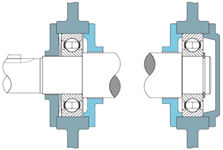Find your bearing easily
Single Row Deep Groove Ball Bearings
Ball bearings are so called because they have balls as rolling elements. The load is transmitted from the outer race to the ball and from the ball to the inner race. Since the ball is a sphere it only contacts the inner ring and outer ring at a very small point, which minimizes friction and helps the bearing to rotate very smoothly. This also means that there is a minimal contact area supporting the radial load therefore if the bearing is overloaded the balls can deform and the bearing will fail.
The single row deep groove ball bearing is used most often in small- and medium-sized electric motors. Due to their low frictional torque they are suitable for high speeds. They can carry radial, axial and combined loads (Fig 1), making them suitable for use in both locating and non-locating positions in the motor. In a non-locating position the bearing is mounted with a small clearance fit in the housing which enables it to move in an axial direction to accommodate thermal expansion and contraction in the shaft. Usually in such cases a wave washer spring is fitted next to the bearing to maintain a preload in the bearing and to prevent the outer ring from rotating in the housing.
 Deep groove ball bearings with shields (2Z) or seals (2RS) on both sides are lubricated for life and require no maintenance.
Deep groove ball bearings with shields (2Z) or seals (2RS) on both sides are lubricated for life and require no maintenance.
2Z 2RS
 „Max-load“ type deep groove ball bearings have an extra ball compared to normal ball bearings of the same dimensions; the inclusion of the extra ball requires a „filling slot“ for assembly. The extra ball enables higher radial load carrying capacity but the axial load carrying capacity is reduced because of the filling slot. The limiting speed is also reduced compared to bearings without filling slots.
„Max-load“ type deep groove ball bearings have an extra ball compared to normal ball bearings of the same dimensions; the inclusion of the extra ball requires a „filling slot“ for assembly. The extra ball enables higher radial load carrying capacity but the axial load carrying capacity is reduced because of the filling slot. The limiting speed is also reduced compared to bearings without filling slots.
Open -Z
Most of ball bearings for electric motors are designed to fit into one or three series of standard dimensions for the bore and outside diameter. The following figure demonstrates the increase or decrease in load carrying capacity in relation to the proportions of the bearing bore. The width dimension may vary depending on the application or requirements for sealing devices, extra radial load capacity and extra grease reservoir.
 Duty Ratings:
Duty Ratings:
62.. series – Light duty
63.. series – Medium duty
64.. series – Heavy duty
The single row deep groove ball bearing is used most often in small- and medium-sized electric motors. Due to their low frictional torque they are suitable for high speeds. They can carry radial, axial and combined loads (Fig 1), making them suitable for use in both locating and non-locating positions in the motor. In a non-locating position the bearing is mounted with a small clearance fit in the housing which enables it to move in an axial direction to accommodate thermal expansion and contraction in the shaft. Usually in such cases a wave washer spring is fitted next to the bearing to maintain a preload in the bearing and to prevent the outer ring from rotating in the housing.

|  |
| Fig 1 | Non-locating bearing Locating bearing |
 Deep groove ball bearings with shields (2Z) or seals (2RS) on both sides are lubricated for life and require no maintenance.
Deep groove ball bearings with shields (2Z) or seals (2RS) on both sides are lubricated for life and require no maintenance.
2Z 2RS
 „Max-load“ type deep groove ball bearings have an extra ball compared to normal ball bearings of the same dimensions; the inclusion of the extra ball requires a „filling slot“ for assembly. The extra ball enables higher radial load carrying capacity but the axial load carrying capacity is reduced because of the filling slot. The limiting speed is also reduced compared to bearings without filling slots.
„Max-load“ type deep groove ball bearings have an extra ball compared to normal ball bearings of the same dimensions; the inclusion of the extra ball requires a „filling slot“ for assembly. The extra ball enables higher radial load carrying capacity but the axial load carrying capacity is reduced because of the filling slot. The limiting speed is also reduced compared to bearings without filling slots. Open -Z
Most of ball bearings for electric motors are designed to fit into one or three series of standard dimensions for the bore and outside diameter. The following figure demonstrates the increase or decrease in load carrying capacity in relation to the proportions of the bearing bore. The width dimension may vary depending on the application or requirements for sealing devices, extra radial load capacity and extra grease reservoir.
 Duty Ratings:
Duty Ratings:62.. series – Light duty
63.. series – Medium duty
64.. series – Heavy duty